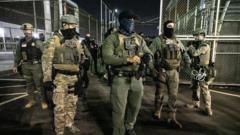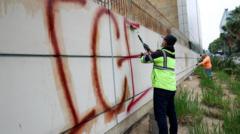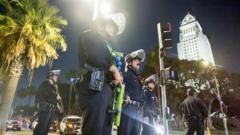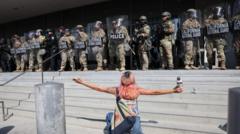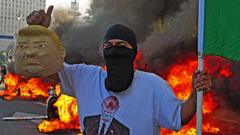The mobilization of troops in Los Angeles to manage immigration-related protests stirs fears of authoritarianism, prompting calls from California officials to restrict military roles.
Military Presence Heightens Tensions in Los Angeles Amid Immigration Protests

Military Presence Heightens Tensions in Los Angeles Amid Immigration Protests
President Trump's deployment of National Guard and Marines in response to protests raises concerns over the use of military force on domestic soil.
Article Text:
In an extraordinary move, President Trump has deployed 4,000 National Guard troops and 700 Marines to Los Angeles in response to escalating demonstrations regarding immigration raids. This deployment, which marks a rare military intervention on American domestic soil, has ignited political tensions as state officials voice their opposition.
California Governor Gavin Newsom criticized Trump’s actions, suggesting they threaten the pillars of democracy. "California may be first, but it clearly won’t end here," he said in a televised briefing, warning that similar military interventions could occur in other states. "Democracy is next," he added, framing the situation as a potential affront to civil liberties.
Political and military analysts are weighing in, noting the unusual nature of a military response to protests that, while disruptive, have not escalated into violence or insurrection. Helene Cooper, a Pentagon correspondent, emphasized that while National Guard interventions are common during natural disasters and riots, they typically occur under the direction of state governors.
The deployment raises significant legal questions, as the Posse Comitatus Act limits the use of active-duty military forces for domestic law enforcement unless under the Insurrection Act—a scenario many believe does not apply in this case. Cooper remarked, "It is hard to see how the Los Angeles protests, which are scattered and not really affecting life in the city in a widespread way, can be seen as an insurrection."
In response to the protests, Los Angeles Mayor Karen Bass has implemented a curfew in downtown, where tensions continue to simmer as thousands of demonstrators gather nationwide. The situation remains fluid, with updates anticipated in the coming days as both state and federal officials navigate the complex interplay of law, order, and civil rights.
In an extraordinary move, President Trump has deployed 4,000 National Guard troops and 700 Marines to Los Angeles in response to escalating demonstrations regarding immigration raids. This deployment, which marks a rare military intervention on American domestic soil, has ignited political tensions as state officials voice their opposition.
California Governor Gavin Newsom criticized Trump’s actions, suggesting they threaten the pillars of democracy. "California may be first, but it clearly won’t end here," he said in a televised briefing, warning that similar military interventions could occur in other states. "Democracy is next," he added, framing the situation as a potential affront to civil liberties.
Political and military analysts are weighing in, noting the unusual nature of a military response to protests that, while disruptive, have not escalated into violence or insurrection. Helene Cooper, a Pentagon correspondent, emphasized that while National Guard interventions are common during natural disasters and riots, they typically occur under the direction of state governors.
The deployment raises significant legal questions, as the Posse Comitatus Act limits the use of active-duty military forces for domestic law enforcement unless under the Insurrection Act—a scenario many believe does not apply in this case. Cooper remarked, "It is hard to see how the Los Angeles protests, which are scattered and not really affecting life in the city in a widespread way, can be seen as an insurrection."
In response to the protests, Los Angeles Mayor Karen Bass has implemented a curfew in downtown, where tensions continue to simmer as thousands of demonstrators gather nationwide. The situation remains fluid, with updates anticipated in the coming days as both state and federal officials navigate the complex interplay of law, order, and civil rights.

